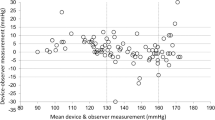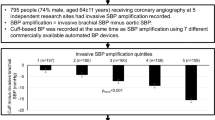Abstract
Using the Sphygmocor device it is recommended that the radial pressure wave is calibrated for brachial systolic blood pressure (SBP) and diastolic blood pressure (DBP). However it has been suggested that brachial-to-radial pressure amplification causes underestimation of central blood pressures (BPs) using this calibration. In the present study we examined if different calibrations had an impact on estimates of central BPs and on the clinical interpretation of our results. On the basis of ambulatory BP measurements, patients were categorized into patients with controlled, uncontrolled or resistant hypertension. We first calibrated the radial pressure wave as recommended and afterwards recalibrated the same pressure wave using brachial DBP and calculated mean arterial pressure. Recalibration of the pressure wave generated significantly higher estimates of central SBP (P=0.0003 and P<0.0001 at baseline and P=0.0001 and P=0.0002 after 6 months). Using recommended calibration we found a significant change in central SBP in both treatment groups (P=0.05 and P=0.01), however, after recalibrating significance was lost in patients with resistant hypertension (P=0.15). We conclude that calibration with DBP and mean arterial pressure produces higher estimates of central BPs than recommended calibration. The present study also shows that this difference between the two calibration methods can produce more than a systematic error and has an impact on interpretation of clinical results.
This is a preview of subscription content, access via your institution
Access options
Subscribe to this journal
Receive 12 digital issues and online access to articles
$119.00 per year
only $9.92 per issue
Buy this article
- Purchase on Springer Link
- Instant access to full article PDF
Prices may be subject to local taxes which are calculated during checkout




Similar content being viewed by others
Change history
15 November 2012
This article has been corrected since Advance Online Publication and a corrigendum is also published in this issue.
References
Williams B, Lacy PS, Thom SM, Cruickshank K, Stanton A, Collier D et al. Differential impact of blood pressure-lowering drugs on central aortic pressure and clinical outcomes: principal results of the Conduit Artery Function Evaluation (CAFE) study. Circulation 2006; 113 (9): 1213–1225.
Avolio AP, Van Bortel LM, Boutouyrie P, Cockcroft JR, McEniery CM, Protogerou AD et al. Role of pulse pressure amplification in arterial hypertension: experts’ opinion and review of the data. Hypertension 2009; 54 (2): 375–383.
McEniery CM, Yasmin, Maki-Petaja KM, McDonnell BJ, Munnery M, Hickson SS et al. The impact of cardiovascular risk factors on aortic stiffness and wave reflections depends on age: the Anglo-Cardiff Collaborative Trial (ACCT III). Hypertension 2010; 56 (4): 591–597.
Roman MJ, Devereux RB, Kizer JR, Lee ET, Galloway JM, Ali T et al. Central pressure more strongly relates to vascular disease and outcome than does brachial pressure: the strong heart study. Hypertension 2007; 50 (1): 197–203.
Laurent S, Cockcroft J, Van Bortel L, Boutouyrie P, Giannattasio C, Hayoz D et al. Expert consensus document on arterial stiffness: methodological issues and clinical applications. Eur Heart J 2006; 27 (21): 2588–2605.
Agabiti-Rosei E, Mancia G, O’Rourke MF, Roman MJ, Safar ME, Smulyan H et al. Central blood pressure measurements and antihypertensive therapy: a consensus document. Hypertension 2007; 50 (1): 154–160.
Pauca AL, O’Rourke MF, Kon ND . Prospective evaluation of a method for estimating ascending aortic pressure from the radial artery pressure waveform. Hypertension 2001; 38 (4): 932–937.
Sharman JE, Lim R, Qasem AM, Coombes JS, Burgess MI, Franco J et al. Validation of a generalized transfer function to noninvasively derive central blood pressure during exercise. Hypertension 2006; 47 (6): 1203–1208.
Nichols WW, O’Rourke MF . McDonalds Blood Flow In Arteries, 5th edn. Oxford University Press Inc.: New York, 2005.
Medical A . Step-by-step for taking a PWA measurement. Available from: http://www.atcormedical.com/pdf/TN1%20-%20%20Instructions%20for%20PWA%20measurement.pdf.
Verbeke F, Segers P, Heireman S, Vanholder R, Verdonck P, Van Bortel LM . Noninvasive assessment of local pulse pressure: importance of brachial-to-radial pressure amplification. Hypertension 2005; 46 (1): 244–248.
World Medical Association Inc. Declaration of Helsinki. ethical principles for medical research involving human subjects. J Indian Med Assoc 2009; 107 (6): 403–405.
Pickering TG, Hall JE, Appel LJ, Falkner BE, Graves J, Hill MN et al. Recommendations for blood pressure measurement in humans and experimental animals: part 1: blood pressure measurement in humans: a statement for professionals from the Subcommittee of Professional and Public Education of the American Heart Association Council on High Blood Pressure Research. Circulation 2005; 111 (5): 697–716.
O’Brien E, Asmar R, Beilin L, Imai Y, Mallion JM, Mancia G et al. European Society of Hypertension recommendations for conventional, ambulatory and home blood pressure measurement. J Hypertens 2003; 21 (5): 821–848.
Calhoun DA, Jones D, Textor S, Goff DC, Murphy TP, Toto RD et al. Resistant hypertension: diagnosis, evaluation, and treatment: a scientific statement from the American Heart Association Professional Education Committee of the Council for High Blood Pressure Research. Circulation 2008; 117 (25): e510–e526.
Van Bortel LM, Duprez D, Starmans-Kool MJ, Safar ME, Giannattasio C, Cockcroft J et al. Clinical applications of arterial stiffness, task force III: recommendations for user procedures. Am J Hypertens 2002; 15 (5): 445–452.
Mahieu D, Kips J, Rietzschel ER, De Buyzere ML, Verbeke F, Gillebert TC et al. Noninvasive assessment of central and peripheral arterial pressure (waveforms): implications of calibration methods. J Hypertens 2010; 28 (2): 300–305.
Rietzschel ER, De Buyzere ML, Bekaert S, Segers P, De Bacquer D, Cooman L et al. Rationale, design, methods and baseline characteristics of the asklepios study. Eur J Cardiovasc Prev Rehabil 2007; 14 (2): 179–191.
Segers P, Mahieu D, Kips J, Rietzschel E, De Buyzere M, De Bacquer D et al. Amplification of the pressure pulse in the upper limb in healthy, middle-aged men and women. Hypertension 2009; 54 (2): 414–420.
Segers P, Rietzschel ER, De Buyzere ML, Stergiopulos N, Westerhof N, Van Bortel LM et al. Three- and four-element Windkessel models: assessment of their fitting performance in a large cohort of healthy middle-aged individuals. Proc Inst Mech Eng H 2008; 222 (4): 417–428.
Acknowledgements
We acknowledge the work of Professor Dr Ir Patrick Segers on this paper and the help of MD Thomas Broecher Christophersen on statistical analysis. We also thank Colorstripe, www.colorstripe.com, for help with artwork. This work was supported by the Danish Heart Foundation, Tømrermester Alfred Andersen og hustrus fond and the Region of Southern Denmark.
Author information
Authors and Affiliations
Corresponding author
Ethics declarations
Competing interests
Trine Koustrup Soender has received a grant from Novartis to cover registration fee for Euroecho in 2009, a grant from GE healthcare to cover registration fee for Euroecho 2010 and a registration fee covering an echocardiographic course arranged by GE Healthcare.
Rights and permissions
About this article
Cite this article
Soender, T., Van Bortel, L., Møller, J. et al. Impact of calibration on estimates of central blood pressures. J Hum Hypertens 26, 706–710 (2012). https://doi.org/10.1038/jhh.2011.97
Received:
Revised:
Accepted:
Published:
Issue Date:
DOI: https://doi.org/10.1038/jhh.2011.97
Keywords
This article is cited by
-
Brachial-to-radial systolic blood pressure amplification in patients with type 2 diabetes mellitus
Journal of Human Hypertension (2016)



